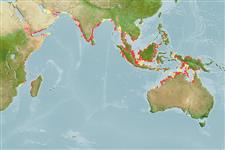Classification / Names
Common names | Synonyms | Catalog of Fishes (gen., sp.) | ITIS | CoL | WoRMS | Cloffa
Elasmobranchii (sharks and rays) >
Myliobatiformes (Stingrays) >
Myliobatidae (Eagle and manta rays) > Rhinopterinae
Etymology: Rhinoptera: Greek, rhinos = nose + Greek,pteron = fin, wing (Ref. 45335). More on author: Müller, Henle.
Environment / Climate / Range
Ecology
Marine; benthopelagic. Tropical, preferred ?
Indo-West Pacific: off India, Malaysia, and East Indies. Validity of this species questioned in Compagno's 1999 checklist (Ref. 35766).
Size / Weight / Age
Maturity: Lm ? range ? - ? cm
Max length : 99.0 cm TL male/unsexed; (Ref. 9916)
Rare species. Ovoviviparous (Ref. 50449). Biology little known.
Life cycle and mating behavior
Maturity | Reproduction | Spawning | Eggs | Fecundity | Larvae
Exhibit ovoviparity (aplacental viviparity), with embryos feeding initially on yolk, then receiving additional nourishment from the mother by indirect absorption of uterine fluid enriched with mucus, fat or protein through specialised structures (Ref. 50449).
Compagno, L.J.V., 1997. Rhinopteriidae. Cownose rays. In K.E. Carpenter and V. Niem (eds.) FAO Identification Guide for Fishery Purposes. The Western Central Pacific. (Ref. 9916)
IUCN Red List Status (Ref. 115185)
CITES (Ref. 94142)
Not Evaluated
Threat to humans
Harmless
Human uses
Fisheries: minor commercial
More information
Age/Size
Growth
Length-weight
Length-length
Length-frequencies
Morphometrics
Morphology
Larvae
Larval dynamics
Recruitment
Abundance
ReferencesAquacultureAquaculture profileStrainsGeneticsAllele frequenciesHeritabilityDiseasesProcessingMass conversion
Tools
Special reports
Download XML
Internet sources
Estimates of some properties based on models
Phylogenetic diversity index (Ref.
82805): PD
50 = 0.5039 [Uniqueness, from 0.5 = low to 2.0 = high].
Bayesian length-weight: a=0.01096 (0.00392 - 0.03068), b=2.98 (2.74 - 3.22), in cm Total Length, based on LWR estimates for this (Sub)family-body shape (Ref.
93245).
Trophic Level (Ref.
69278): 3.6 ±0.5 se; Based on size and trophs of closest relatives
Resilience (Ref.
69278): Low, minimum population doubling time 4.5 - 14 years (Fec assumed to be <100).
Vulnerability (Ref.
59153): Moderate vulnerability (39 of 100) .
